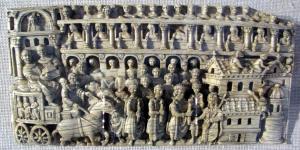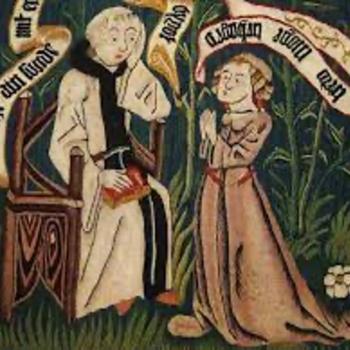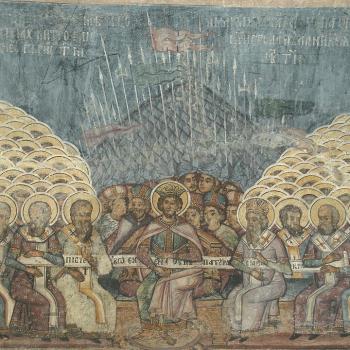The Council of Chalcedon is famously the standard of Christological orthodoxy. The definition put forth in 451 outlines how the “saintly fathers” all confess “one and the same Christ, Son, Lord, Only-begotten, acknowledged in two natures without confusion, change, division, or separation” (Price and Gaddis, The Acts of the Council of Chalcedon, 5.204). As with all important theological documents from church history, there can be a danger of decontextualizing them—of forgetting the time, place, and people who shaped the language and categories found therein. An often forgotten key to understanding and contextualizing the council of Chalcedon (indeed, the entire course of the Christological controversies in the early 5th century) is the person who steered it: Pulcheria, the empress.
We even see evidence of her importance after the proceedings at Chalcedon, when the bishops praised Pulcheria: “It is you who drove out the heretics,” and “To the Augusta many years, to her who is pious and Christ-loving!” (The Acts of the Council of Chalcedon, 6.241) Pulcheria, a laywoman, was given praise from these clergymen because she had been embroiled in two Christological controversies, siding with ‘orthodoxy’ in both instances, despite her brother (the emperor) supporting those eventually deposed of heresy.
The Monastic Princess
Aelia Pulcheria was born in January of 398 or 399, the granddaughter of Theodosius I—the emperor who made Christianity the official religion of Rome. Her parents, Eudoxia and Arcadius, passed away during her youth, the former in 404 and the latter in 408. This left the throne to Theodosius II, who was only 7 years old at the time. Eventually, Pulcheria took charge of her brother’s education and acted as his guardian at just 15 years old, for which she was proclaimed Augusta by her brother. It appears that she was wise beyond her years though, an expert in Greek and Latin, who was able to lead with a shrewd political sensibility.
From 414 onwards, Pulcheria’s leadership took a decidedly monastic tone. The palace in Constantinople, a place of decadence and extravagance, became a house of prayer and virginity. The ancient church historians, Socrates and Sozomen, record that these imperial siblings prayed at certain hours, recited hymns together, and learned the Scriptures by heart. In all of this, Pulcheria “strove chiefly, to lead him (Theodosius) into piety, and to pray continuously; she taught him to frequent the church regularly, and to honor the houses of prayer with gifts and treasures” (Sozomen, Ecclesiastical History 9.1; See also: Socrates, Ecclesiastical History 7.22).
Pulcheria also became a consecrated virgin, committing herself to God in an act of public worship. “She first devoted her virginity to God, and instructed her sisters in the same course of life… In confirmation of her resolution, she took God, the priests, and all the subjects of the Roman empire as witnesses to her self-dedication” (Sozomen, Ecclesiastical History 9.1). And while some ancient and modern sources have speculated that she did this to retain power (rather than marry and have her husband crowned emperor), there is reason to believe that she was truly motivated to live as a holy virgin, especially in light of her grand acts of charity. “They (Pulcheria and her sisters) all pursue the same mode of life; they are sedulous about the priests and the houses of prayer, and are munificent to needy strangers and the poor” (Sozomen, Ecclesiastical History 9.3). Pulcheria was beloved by her subjects for her philanthropy from her teenage years onwards.
Pulcheria remained unmarried for nearly the rest of her life, until her brother’s death. Theodosius II died in 450, leaving behind no male heir to lead. Thus, the throne fell to Pulcheria, who ruled alone for about a month before marrying Marcian, a tribune, as required by Roman law. Pulcheria set forth a condition for their marriage though: it was to remain a celibate one. Thus, she was a consecrated virgin until her death, despite being married.
The One Who Drove Out the Heretics
Pulcheria’s entrance into theological controversies was with Nestorius, just five days after he became bishop of the imperial city, Constantinople. Apparently, she and her brother went to church to receive communion on Easter 428, in the Holy of Holies with the priests. Nestorius met her at the door and denied her entry, insisting that “only priests may walk here.” She asked: “Why? Have I not given birth to God? He replied: “You? You have given birth to Satan!” (Letter a Cosme 5-7 (Patrologia Orientalis XIII, 278; translation from Holum, Theodosian Emperesses, 153). Two elements of this exchange are noteworthy. First, Pulcheria clearly roots her spiritual authority in Mariology, that a woman gave birth to God. Second, Nestorius had not yet popularized his views rejecting the Theotokos (the title, Mother of God), for which he was eventually condemned, but he clearly had opposing theological sensibilities than Pulcheria on the role of Mary and women generally.
To avoid bogging you down with the theological details, it is worth noting that Pulcheria was instrumental in the following years, leading to the Council of Ephesus in 431. Theodosius was a staunch supporter of Nestorius, the bishop of his city, despite Pulcheria’s disdain for the man. Eventually, Cyril of Alexandria wrote to the imperial palace, pleading for Theodosius to reconsider his theological allegiance in Address to the Pious Emperor Theodosius on the Correct Faith. But, this was not the only work that he sent—he also wrote Address to the Most Pious Princesses, and Address to the Most Pious Empresses on the Correct Faith, in which he encouraged the royal women—foremost, Pulcheria—to convince Theodosius to see truth. Eventually, Nestorius is deposed at the council, for which Pulcheria seems to have a hand—both sides of the debate claim that she was the reason for Nestorius’ demise (See: Nestorius, The Bazaar Of Heracleides, 146-7; Leo, Letter 31).
Leading to Chalcedon, a similar series of events takes place, though with a different Christological heresy popularized by Eutyches. Pulcheria favored Eutyches’ deposal in 448 for the rejection of the language proposed after Ephesus, called the Formula of Union, even though Theodosius favored the so-called ‘Robber Council of Ephesus’ in 449, which vindicated Eutyches. At this point, another important ecclesiastical figure, Pope Leo, wrote to Pulcheria asking for her assistance (Leo, Letter 31) in condemning Eutyches at an ecumenical council. After her brother’s death, Marcian called the council of Chalcedon (Leo, Letter 73; See: The Acts of the Council of Chalcedon, 1.92), though there is no doubt that Pulcheria was the true force behind this decision. In the end, Eutyches was deposed and Pulcheria, once again, had fought for the side of orthodoxy. In a letter defending the council in its aftermath, Pulcheria writes, we must “confess that the Saviour Christ is one and the same Jesus Christ, perfect God and perfect man, the same God truly and the same man truly, in no way divided or converted” (Pulcheria, Pulcheria to Archimandrites in Jerusalem). All of this led to the bishop’s adulation: “It is you who drove out the heretics.”

The New Helena
In my first post about the Mothers of the Church, I talked about the visibility problem—that there is a tendency to look past the contributions of women of faith in the early church. In some ways, Pulcheria seems to be more visible than others: She is a saint in both the Eastern and Western Churches, her feast day being held on September 10th. Further, the bishops at Chalcedon, as mentioned, recognize her devout faith and fight for Christological orthodoxy. This praise is at its peak when they claim that “Marcian is the New Constantine, Pulcheria the New Helena! You have shown the faith of Helena. You have shown the zeal of Helena. You defend the cross of Christ. Helena found it, Pulcheria rescued it” (Acts of the Council of Chalcedon, Acts 6.240). Helena is the mother of Constantine, who was famous for her piety, the model of imperial Christianity for women—something that Pulcheria, apparently, embodied perfectly.
But how does attributing the title ‘new Helena’ shift how we might approach Pulcheria? She is chiefly seen as important in relation, as the wife of the truly important figure—in other words, she has little to no political or theological achievements in her own right. And this is reflected not only in the ancient context (Socrates and Theodoret, for instance, basically pretended that she didn’t exist), but in our modern one. For example, neither the 19th century nor 20th century English translations of Leo’s Letters translate Epistle 77—a letter from Pulcheria to Leo. Apparently, either the content, or the author, was not important enough to disseminate to modern audiences. In evaluating all that Pulcheria accomplished, perhaps it is worth reconsidering her title as the New Helena—by most metrics, she, not her husband, is the ‘New Constantine’, the orchestrator of a church council. Her faith shaped not just her household, but the trajectory of the Christian faith itself–something that we’d do well to note and remember this Women’s History Month.”
Resources:
Primary sources: As far as I can tell (though someone please point this out, if I have missed it!), there are only 4 extant letters from Pulcheria’s own hand—all of them deal with the council of Chalcedon and its aftermath. These can all be found in various places in Coleman-Norton’s Roman State & Christian Church: A Collection of Legal Documents to A.D. 535 vol 1, and several can be found in Price and Gaddis’ The Acts of the Council of Chalcedon. The original source (in Greek) is listed, with accessible English translations in the hyperlinks.
Acta Conciliorum Oecumenicorum 2.1.1 ep. 9, p. 9-10 (Pulcheria to Leo, Nov. 450)
- Price and Gaddis, The Acts of the Council of Chalcedon, Document 3 (1, pg. 93-4)
- Coleman-Norton, Roman State & Christian Church, Document 463 (pg. 769-70)
Acta Conciliorum Oecumenicorum 2.1.1 ep. 15, p.29 (Pulcheria to Governor of Bithynia, Strategios, Sept 451)
- Price and Gaddis, The Acts of the Council of Chalcedon, Document13 (1, pg. 107-108)
- Coleman-Norton, Roman State & Christian Church, Document 466 (pg .773-4)
Acta Conciliorum Oecumenicorum 2.1.3 ep. 27, p. 127-129 (Pulcheria to Archimandrites in Jerusalem, Late 452 or Early 453)
- Coleman-Norton, Roman State & Christian Church, Document 486 (pg 842-4)
Acta Conciliorum Oecumenicorum 2.1.3, ep. 31, p. 136 (Pulcheria to Abbess Bassa, likely 453)
- Coleman-Norton, Roman State & Christian Church, Document 485 (pg 840-1)
Secondary Sources: There are not many modern works on Pulcheria, despite her prominence, but a few can orient you to the literature available:
Kenneth G. Holum, Theodosian Empresses: Women and Imperial Dominion in Late Antiquity (Los Angeles: University of California Press, 1982).
Vassiliki Limberis, Divine Heiress: The Virgin Mary and the Creation of Christian Constantinople (New York: Routledge, 1994), Ch. 3.
Liz James, Empresses and Power in Early Byzantium (London: Leicester University Press, 2001)
Kathryn Chew, “Virgins and Eunuchs: Pulcheria, Politics and the Death of Emperor Theodosius II,” Historia: Zeitschrift für Alte Geschichte, 55; 2 (2006), 207-227.
Philip Jenkins, Jesus Wars: How Four Patriarchs, Three Queens, and Two Emperors Decided what Christians Would Believe for the Next 1,500 Years (New York: HarperOne, 2010).













